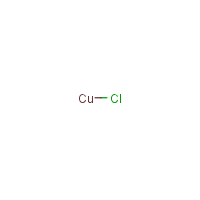Copper(I) chloride
Agent Name
Copper(I) chloride
Alternative Name
Cuprous chloride
CAS Number
7758-89-6
Formula
Cl-Cu
Major Category
Metals

Synonyms
Chlorid medny [Czech]; Copper monochloride; Copper(1+) chloride; Copper chloride; Cuprous chloride; Dicopper dichloride; [ChemIDplus] Cu-lyt; [Merck Index] Cuprous dichloride; [Reference #1] Cuprous Chloride Technical; Migratol R001; [Reference #2] UN2802
Category
Metals, Inorganic Compounds
Description
White solid; Turns green on exposure to moist air, and blue to brown on exposure to light; [Merck Index] Insoluble in water (0.1 g/L); [Ullmann] Grey-tan to light green odorless powder; [Reference #2]
Sources/Uses
Used to produce other copper compounds and in the production of silicone polymers, ethylene-propene rubbers, dialkyl carbonates, and acrylonitrile; Also used to purify carbon monoxide and to produce phthalocyanine pigments; Occurs in nature as nantokite; [Ullmann] Used as a catalyst for organic reactions, decolorizer, catalyst, and desulfuring agent in the petroleum industry, in denitration of cellulose, as condensing agent for soaps, fats, and oils, and in gas analysis to absorb carbon monoxide; [Merck Index] Used in Korea as a raw material for coloring agents and as a catalyst for CO and H2 production; [Reference #1] Used to control plant root growth in nursery pots (incorporated into the plastic); [Reference #2]
Comments
Harmful if swallowed; [MSDSonline] Acute copper poisoning after ingestion can cause liver injury, methemoglobinemia, and hemolytic anemia. Acute renal failure may result, secondary to massive hemoglobinuria. [Goldfrank, p. 1259] Classified as category I for skin and eye irritation (corrosive); Category II for acute oral and dermal exposure (moderate toxicity); Category III for acute inhalation exposure (low toxicity); Positive results in dermal sensitization studies; [Reference #2] May cause irritation; Harmful by ingestion; [Alfa Aesar MSDS] See "Copper."
Reference Link #1
Biomedical References
Exposure Assessment
TLV (ACGIH)
1 mg/m3, as Cu
PEL (OSHA)
1 mg/m3, as Cu
MAK
0.01 mg/m3, respirable fraction (Cu, inorganic cmpnds)
IDLH (NIOSH)
100 mg/m3, as Cu
Lethal Concentration
LC50 (mice) = 1,008 mg/m3
Explanatory Notes
mp = 430 deg C; [MSDSonline]
Reference Link #2
Adverse Effects
Anemia
Hemolytic anemia
Methemoglobinemia
MetHgb is secondary toxic effect
Hepatotoxin
Hepatoxic (a) from occupational exposure (secondary effect) or (b) in animal studies or in humans after ingestion
Nephrotoxin
Yes
Diseases, Processes, and Activities Linked to This Agent
Processes
Industrial Processes with risk of exposure: